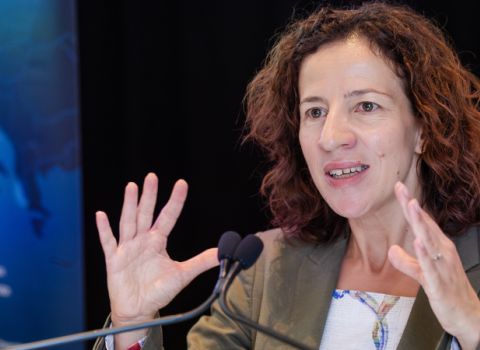They were promised more money, but in the first year of the revamped EU student mobility scheme universities got less - leaving students facing uncertainties over their grants. Some say such hiccups are to be expected when new rules are kicking in

The revamped seven year student mobility programme Erasmus+ had a rocky start in 2021, after drawn out EU budget negotiations delayed the first calls. Universities scrambled to send their students on exchange visits, as the number wanting to study abroad returned to pre-pandemic levels.
This is despite the fact that when the European Commission launched Erasmus+ with fanfare in March 2021, it promised twice the budget of the previous seven years, at €26.2 billion. There also was a pledge to make the programme more accessible to students from disadvantaged backgrounds, those with disabilities, and others who have so far struggled to benefit from the EU’s student mobility funding.
The delays meant that in the first year Erasmus+ allocated €705 million, down from €930 million in 2020. This caused issues for universities which were expecting to get more money.
“The expectation is that this budget always grows and you make an estimate based on the number of students [funded] the previous year,” said Ivana Didak, senior policy officer at the Guild of European Research-Intensive Universities. Universities were encouraged to use up leftover funds from previous years, and while this worked for some, others had little left on their balance sheet.
Students were affected by the shaky start of the programme. Juan Rayón González, president of the Erasmus Student Network, said many students went on the exchange without knowing if their grants were secured. “Some were not sure if they would even receive grants. Others didn’t know if they could go in the second semester,” he told Science|Business.
Different experiences
Before universities receive the EU funds to send their students for a semester abroad they make annual forecasts of how many exchanges they will have to fund. Usually, there’s a slight increase in the budget and the number of students.
In 2021, as the new Erasmus+ programme got off the ground, the European Commission assigned a lower budget than the previous year, reasoning there would be a surplus from 2020, when the pandemic cut demand. But after two years of uncertainties and interrupted exchanges, some institutions had less money in the Erasmus+ student account than others.
To counter this, the Commission allowed some flexibility. Universities could, for example, use money from other parts of the Erasmus+ programme to fund exchanges. Many used money designated for incoming students to send out their students abroad.
“Those are quick fixes, but this is really not what the programme is supposed to be about, especially when we know there is enough funding available,” said Didak.
Some governments moved to bridge the funding gaps. The Irish government provided €7 million over two years to allow more students to go abroad.
Austria also helped universities that did not have leftover funds. “It was a difficult situation but it has improved a lot. The national agency provided some national budget so the situation improved,” said Karin Krall, Erasmus institutional coordinator at the University of Vienna’s International Office.
For students, all this translated into delays getting the funding and uncertainties about whether they would even be allowed to go. While around 27% of students generally receive the grant at least one month after starting, this year, in some countries, the number and doubts about the funding shot up much higher.
Didak says many universities were expecting problems during the transition from the old Erasmus scheme to the new and were careful in organising exchanges for 2021. Some applied for less money, planning fewer exchanges. Others were expecting a lower budget and so applied for more money than usual.
The University of Barcelona reported the situation was ‘not dramatic’ because it was well prepared and had quite a few cancellations. “The problem here is when you don’t have the capacity to react,” said Raul Ramos, vice-rector for international policy.
Caught in bureaucracy
The new Erasmus+ is rather different from its predecessor in having a bigger focus on blended mobility that allows students to do part of the exchange remotely, and top-up grants for participants with disabilities, those coming from remote locations or disadvantage backgrounds and migrants, including up-front payments for the initial costs of taking part.
Those that travelled with money from the old programme were not eligible for any upgrades in the new one. This led to confusion, says Rayon.
“What you have this year is that we had students from the previous Erasmus+ calls and the new programme,” said Rayon. “This is quite problematic because of the bureaucracy. This combination of confusions led to many problems on the ground.”
Although some lumpiness is expected during the transition between programmes, this time around it was aggravated by late publication of the details. By the time universities were on top of the rules and regulations, some students had already gone on their autumn exchanges. “The problem was that many [exchanges] had already started, students were going into confusing situations, and this is why we kept on receiving complaints,” said Rayon.
Taking the time
The good news is that students funded by the previous budget are not missing out on too much. Universities are still preparing to take on all the new features of the new Erasmus+.
For example, KU Leuven will start by piloting blended mobility. The university delivered fully online learning during the pandemic and now plans to test several online programmes with the students in the engineering technology faculty.
Peter Lievens, KU Leuven’s vice rector for international policy, says the push for blended mobility is helping develop the technology backbone needed to further enable these programmes, and will feed into KU Leuven’s work with other universities in its Erasmus-funded university alliance, UNA Europa. “It’s one of the topics that is high up on the agenda of our European university alliance, where we really want to make this an instrument that can be used everywhere,” Lievens said.
Similarly, the University of Vienna is also not in a rush to fully implement blended mobility. “All the regulations and specific information on the new schemes were published rather late so we wanted to start on a small scale to see what the challenges are, what are the problems, and not start with a lot of short-term programmes and see that things don’t work how we imagined,” Krall said.
The same applies to the University of Barcelona which planning to start small-scale and then grow the blended mobility programmes. “Preparation is difficult because we need to think about the added value,” said Ramos. “It’s giving a solution to a profile to students that could not do it traditionally.”
The student association prefers universities moving slowly but surely. “These new elements that Erasmus has can be very beneficial, it’s very important that guidelines are implemented especially for blended mobility,” said Rayon.
The one good thing coming out of the pandemic is that university staff member are much more open to remote teaching than before the pandemic, when the work on the new Erasmus+ programme started, noted Krall.
Next year
Next year, the budget for mobility is likely to be increased to around €997 million and the schedule should be back to normal. Universities are hopeful about the coming years of Erasmus+. “From what we know, most of the problems that we have now will be solved,” said Rayon.
There is a lingering concern in that funding for mobility is set to increase massively in the coming years, with the new Erasmus+ expected to benefit 12 million people, three times more than its predecessor. This means universities need to quickly build up the capacity to send more students on exchanges.
Rayon also noted there should be national funding to supplement Erasmus+ when needed and stressed the importance of aiming to pay the students their grants before they set off.
From the current vantage point, the second year of Erasmus+ looks like to be smoother. Moving from one programme to another is never easy. “It was rather frustrating, but this transition is always very difficult,” said Krall.





 A unique international forum for public research organisations and companies to connect their external engagement with strategic interests around their R&D system.
A unique international forum for public research organisations and companies to connect their external engagement with strategic interests around their R&D system.